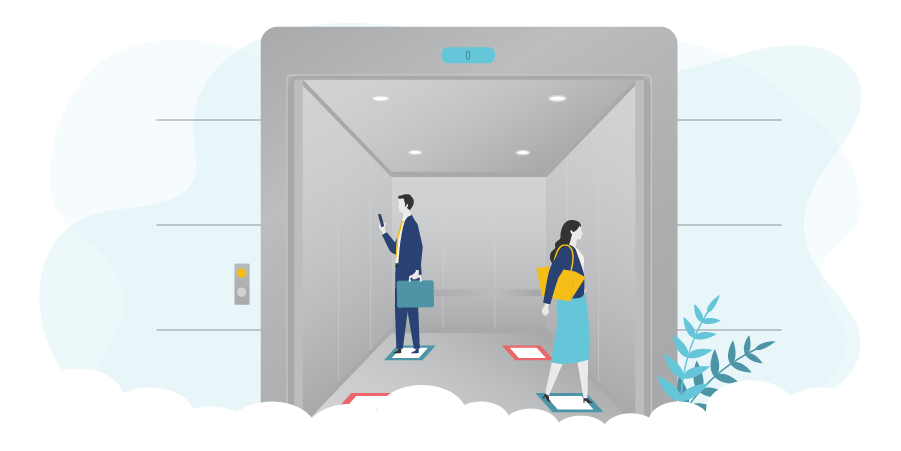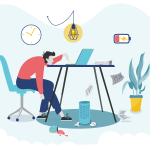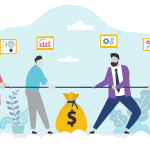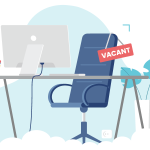Back to Normal? Helping Employees Prepare for Work After the Pandemic
July 14, 2021

For the last year and a half, remote work has dominated corporate conversations. From the rapid transition home to business model disruptions to communication gaps and more, no one could have predicted the changes brought on by COVID-19. But with vaccine rollout well underway, restrictions are easing and the conversation is now turning towards the challenges of returning employees to the office.

In addition to safety, social distancing, and hygiene, employers will also need to address health and wellness. While work-related stress and fatigue were rampant long before the COVID-19 hit the scene, few organizations were truly prepared for the impact that months of social distancing, isolation, and economic uncertainty would have on workers’ physical and mental well-being. Employees across all industries are dealing with burnout, chronic pain, anxiety, but most companies remain ill equipped to address the problem.
What challenges lie ahead? How can employers combat rising levels of stress and burnout? How can they support staff as we integrate into a post-pandemic world? Keep reading to learn more.
Disclaimer: Please note that the information provided herein is general in nature and will not apply to all business, workplaces, employers, employees and situations. It is not exhaustive and does not constitute legal, employment, or insurance advice. For more guidance, please consult a lawyer and/or a licensed insurance representative.
Employer’s Top Reopening Challenges:
1. Fatigue and Burnout
While most workers are no strangers to fatigue and stress, Canadians are reporting record levels of mental distress. Findings from the Canadian government’s 2021 Survey on COVID-19 and Mental Health indicate that about one in five (21%) adults screened positive for at least one of three mental health conditions: major depressive disorder, generalized anxiety disorder, and post-traumatic stress disorder (PTSD).
Why? Most people have spent the last year and a half confined at home, moving between lockdowns, and isolated from friends and family, all while worrying about job security and caring for children and/or sick relatives. On top of that, blurred boundaries between home and work life and unprecedented workloads have limited most opportunities for personal downtime.
People are tired. They’re unmotivated. Exhaustion—and cynicism—have set in. The next step? Burnout, a state of complete and total “emotional, physical, and mental exhaustion caused by excessive and prolonged stress.” A global survey by Catalyst found that 92% of workers say they’re experiencing burnout from stress related to their workplace, their COVID-19 work experiences, and/or their personal lives.
Burnout is a serious problem for employers. Burned out employees are likely to make mistakes, provide sub-par services, and cost the company clients in the long-term. Even one unmotivated or disengaged worker can cause team disruptions, affect workplace morale, and increase turnover, especially if organizations fail to respond appropriately or effectively and other employees have to step in to pick up the slack.
2. Chronic Pain
Health experts are predicting an influx of chronic conditions following the pandemic due to numerous stressors that have exacerbated pain, injury, and suffering over the past year, even in the absence of viral illness. According to the Chronic Pain & COVID-19 Pan-Canadian Study, two-thirds of individuals surveyed reported worse pain since the beginning of the pandemic, with low-income populations among the most affected.
Reports have spiked largely due to:
Healthcare Backlog
For many, regular medical care has been compromised over the last year due to concerns over virus transmission, as well as the lack of medical supplies and available personnel. Routine clinics may have been less accessible or closed, pain medications diverted to emergency care, and waiting times prolonged for any “non-urgent” conditions. With COVID-19 patients filling ICUs, elective and non-emergency surgeries, pain management procedures and therapies, and specialist consultations have been postponed several times since March 2020, potentially worsening people’s symptoms in the meantime.
Personal Issues
Countless workers have put their health on hold throughout the pandemic for a number of reasons: personal fears about the risk of infection, unwillingness to take public transit, or even inability to take time away from children or work. Even with advances in telehealth care, many might not have proper access to or be fully comfortable with virtual services. And for those who have lost their jobs or taken pay cuts, the vital treatments and medications needed to relieve pain may no longer be affordable.
Home Offices
Seemingly overnight, employees, majority of whom were working from home for the first time, had to hastily set up workstations that would last them for the foreseeable future. People had to get creative fast, particularly those living in smaller spaces, with many working from their beds or couches and using dining sets, coffee tables, or even ironing boards as desks.
But over a year of making do has taken its toll on our bodies. And with material shortages and high demand, not to mention the cost of ergonomic supports, many people just haven’t had the time or the funds to invest in a better setup. Once-healthy workers have developed repetitive stress injuries and chronic conditions, like back, shoulder, and joint pain, tension headaches, stiffness, and carpal and cubital tunnel syndrome, that they’ll have to endure for the rest of their lives.
Burnout
In addition to mental and emotional exhaustion, burnout is often accompanied by various physical symptoms, such as back aches, chest pain, headaches, heart palpitations, dizziness or fainting, loss of appetite, gastrointestinal pain, low mood, and sleep disorders sleeping too much or too little).
Given the above factors, it’s unlikely that most individuals with either pre-existing or newly developed conditions will return to their pre-pandemic state once COVID-19 is over. Rates of chronic pain will continue to rise over time, with a wide range of repercussions on people’s daily lives, including their mental health, ability to work, and work performance.
Lack of Physical Activity
With gyms, pools, exercise facilities, and other group activity programs closed for much of the last year, exercise and fitness regimens, which are crucial to chronic pain management, have taken a hit. And at home, people may not have the space, equipment, or resources they need to sufficiently treat their conditions.
RELATED: How “free” is Canadian healthcare?
3. Re-entry Anxiety
Although many people are looking forward to regaining a sense of normalcy, numerous studies show that a substantial portion of the Canadian workforce is worried about going back to the office. Some are concerned about the logistics of child- or eldercare, while others are nervous about the risk of virus transmission in the workplace given the divisive responses to COVID-19 protocols, masking, and vaccination. Employers might even face pushback from workers who don’t want to come in because everyone isn’t vaccinated.
Additionally, for many employees, working from home has afforded them a chance to get more time back out of their day. Instead of spending hours commuting, people have been able to use that time to run errands, cook, or squeeze in a workout. Some workers may be worried or upset about losing this time or disrupting their newly established routines.
Finally, many people are also anxious about the effects of a year’s worth of isolation on their communication and social skills. Going back to an environment where social engagement and conversation are constant may be overwhelming and stressful for anyone with social anxiety.
RELATED: How Can Employers Navigate the Challenges of COVID-19 Vaccinations?
4. Engagement and Morale
Employee engagement and morale are integral to company culture and reducing turnover. With people working from home and putting in extra time where needed, engagement and productivity have been high all year. But according to Microsoft’s annual Work Trend Index, high productivity has masked worker exhaustion on a global scale. With burnout on the rise and wellness levels decreasing, employees’ commitment to job demands is likely to fall. In fact, 37% of the global workforce says their companies are asking too much of them at a time like this.
Even worse? A remote environment may have left employers out of touch. Despite Zoom lunches, virtual happy hours, and online team building sessions, there’s no substitute for real, in-person human connection. Plus, company events, lunchroom chitchat, and even impromptu encounters in the hall allow senior managers and executives to check in with employees and pick up on important social cues. Without those interactions, business leaders may not even be aware of all the issues their employees are struggling with.
And what happens when employees don’t feel heard by senior management? When they don’t feel supported, appreciated, or actively included? They start reevaluating their priorities. Morale takes a dip—and turnover rates spike. Microsoft’s study also revealed that over 40% of the global workforce is likely to consider leaving their employer in the next year, with almost half (46%) poised to make a major career shift.
5. Retention and Hiring
Another big challenge? Employees may not want to return at all. The demand for remote work has been building for decades; COVID-19 has merely accelerated this transition. And now that employees finally have a work-from-home arrangement, they might not be inclined to give it up. In 2020, CIRA’s Internet Factbook survey found that one-third of Canadian professionals now say they’d be unwilling to work for a company that doesn’t allow telework.
Plus, after spending more time at home working or with family, many have taken advantage of the pandemic’s real estate boom to invest in a bigger space. And people aren’t just buying bigger homes, they’re moving farther away. 46% of employees say they’re likely to move because they can now work remotely and 22% are considering or planning a move more than 50 miles away from their current job.
When reopening, the ability not just to work from home, but to work from anywhere, will be a serious competitive advantage as the new expected employee norm. If business leaders are unwilling to accommodate workers, they might take their talents elsewhere.
Employees’ wandering eyes could even take them across the border. With a good chunk of the US fully vaccinated, the upcoming changes to immigration, and a growing focus on research, development, and innovation, Canada’s severely at risk of a brain drain if skilled workers head south to capitalize on superior opportunities.
How can I support employees through this transition?
Since the start of the pandemic, many organizations have responded with virtual seminars, stress-reduction workshops, and yoga classes, with the hopes of encouraging behavioural change by improving people’s knowledge of nutrition and exercise. But more often than not, these initiatives are seen by employees as yet another thing to do and have failed to address the real sources of energy drain. The truth is: employers rarely consider the workplace itself as a cause for physical and psychological strain.
To recover as we move forward, business leaders must make an organizational shift towards resetting working practices and take a holistic approach to wellbeing. Employers should reorganize the work environment as much as possible to prevent stress, pain, and low morale, not just to help employees adapt back to the office, but to pave the way for a positive workplace culture centred on wellness and resilience.
Here are some tips for you to get started:
1. Pay attention.
Open up the lines of communication. Check in regularly with your employees if you aren’t already and find out where they stand mentally and emotionally. Ask questions and look for signs of distress. Are people working longer hours? Why? Do they need support for personal or mental health issues that may affect their performance? Have they had time off recently? If not, are there any issues preventing them from doing so?
Don’t guess or assume what workers want; poll them on what they need and expect from a post-coronavirus workplace. Conduct a survey and get feedback on: the desire to return to the office, thoughts on remote work, satisfaction with management, productivity rate, health concerns, and what types of safety measures they would like to see in the office. Not only will this give you a better idea of re-entry anxiety, it’ll foster a sense of inclusion around company decisions.
RELATED: Business as Usual? The Employer’s Guide for Returning to Work
2. Hone down your return to work and remote work policies.
Will people be expected to return permanently? Or will you continue to offer remote work once the pandemic is over? If so, detail your expectations for employees, managers, and teams.
Be thorough and consider all issues. Will workers be able to work from anywhere? If some members of a team work from home, how will they participate in meetings? Which groups of employees will return first and when? Will you expect all employees to be vaccinated? Should managers be trained (or re-trained) on supporting a partially remote team?
If employees want to stay at home, try hybrid work to combine remote and in-office models. If you’re hesitant, consider investing in technologies that help you monitor task progression and resources spent.
3. Lead with empathy.
Be patient and be ready to listen to other people’s needs. When workers eventually get onsite, don’t overload them in the first few days; give them time to adjust from working in a quiet, secluded space to a noisy, crowded environment. Consider reorientation programs and informal events to help re-establish team spirit and cohesion.
RELATED: Coping with COVID-19: The Small Business Guide to Reopening, Relief, & Recovery
4. Create flexible work arrangements.
Empower people to work flexible hours. If they don’t need to be available 9-5, try to let workers have more autonomy and control over their day—it may take a lot of the stress off work and help them to enjoy a healthier work-life balance. How? By giving them adequate time for personal activities and allowing them to recharge without feeling guilty about it. Keep in mind though, everyone is different, so you’ll need to determine what works best for each employee and design work patterns accordingly.
5. Create fair workloads.
The last year has been tough on all businesses. Between layoffs, pay cuts, and work disruptions, everyone has been putting in more time. But overloading your employees with a heavy workflow ultimately increases stress, lowers productivity, and limits output.
Instead, have honest discussions about managing workloads when working, both remotely and in-office, to ensure a fair distribution of responsibilities, combat fatigue, and prevent burnout. Communicate all tasks clearly and assign reasonable deadlines at appropriate intervals. Check in frequently. Provide adequate training and resources to guide employees in completing tasks. And encourage frequent breaks or set certain rules to give workers time to unwind between projects, like meetings-free Fridays or forbidding work emails after a set time.
6. Be supportive.
It’s important to walk the walk and not just talk the talk. Workers have to feel like it’s okay for them to step out for an appointment or take a vacation or sick day for themselves. While some employees have put off their vacations due to COVID-19, others may be worried about workplace backlash, deterring productivity, or even job security.
But time off is necessary to take breaks from work. Try to lead by example and model the characteristics of your employee wellness plan. Encourage your teams to catch up on appointments and time off by doing so yourself. Avoid emailing employees at night or schedule your emails to go out in the morning so they don’t feel the need to be “on” constantly.
And above all, encourage employees to put their health first. Help them feel safe and reassure them that the company will be fine in their absence. If need be, give employees an additional day off here and there to help them cope with the pressures of the pandemic or readjusting to work.
7. Show appreciation.
Make sure work is rewarding. Celebrate wins, even the small ones, when goals and priorities are completed. Employees thrive when they feel their work matters, makes a difference, and is valued.
8. Expand your wellness supports.
When done well, employee wellness programs can offer immense value, particularly if they support inclusive environments, promote physical activity, or offer mental health counselling. But it’s critical to measure their success. How actively are colleagues engaged? Are people using these services? Are they sticking to them? What kind of impact are you having?
It’s not enough to just launch an initiative. If you see a wellness program as just another item to cross off on your checklist, that’s how your employees will see them too. Rather than just rolling out a new seminar or workshop, be strategic and look at engagement. Listen to your staff and pick programs that will have the greatest benefit for their needs. Test them. Monitor them. Learn what works and adapt as needed.
Consider solutions that go beyond traditional offerings, like:
-
Free subscriptions to mental health apps and platforms;
-
Access to virtual exercise, meditation classes, and fitness and nutrition coaches;
-
Financial counselling services;
-
Child- or eldercare programs;
-
Group benefits plans and Health & Dental Insurance to help employees pay for costs that provincial health care plans won’t cover; and
-
Employee Assistance Programs (EAPs) that provide access to licensed mental health professionals and counselors;
-
And more.
And lastly, make it easy to access help—communicate, be transparent, and ensure all programs are visible, affordable, and accessible.
9. Work with a broker.
Finding the right wellness program can be challenging for SMBs who lack the expertise and scale of their larger competitors. But how do you know what’s best and most of all, how will you sustain your plan in the long run? Benefits are costly. And managing them is difficult and time-consuming, especially for small business owners who already wear many hats.
That’s why it’s key to work with a licensed broker—like PROLINK—that understands the unique risks you face, regardless of your company’s size, workforce, or trade. PROLINK’s Protect & Perfect risk management approach to group benefits will help you secure a comprehensive, fully customizable program that reflects your staff’s needs, business challenges, and financial goals.
Our dedicated advisors will:
-
Identify challenges and explore all available options to help you make an informed decision;
-
Align your organization with an insurance provider that offers flexibility in healthcare choices and gives employees more value from their benefits; and
-
Continuously monitor your plan so that it evolves to meet your needs long-term while keeping costs predictable.
10. Be consistent.
As we slowly return to normal, it is clear that there is no one-size-fits-all solution to recovery. And while the efforts noted above may help employees readjust with minimal stress and anxiety, they’re not enough—not in the short run anyway.
Consistency is key. If we see these initiatives as quick fixes, they will fail. Rather, businesses must accept staff health and wellness as a continuing responsibility and work towards integrating self-care and wellness into their organizational structure. Towards nurturing human connection and caring all the time, not just upon our return to the office. Without this fundamental structural and cultural transformation, the workplace problems unleashed by the pandemic will persist long after COVID-19 is gone.
For more comprehensive guidance about your organization, your continuity planning, or your business insurance, please connect with PROLINK. We are only a call or an email away.
PROLINK’s blog posts are general in nature. They do not take into account your personal objectives or financial situation and are not a substitute for professional advice. The specific terms of your policy will always apply. We bear no responsibility for the accuracy, legality, or timeliness of any external content.




